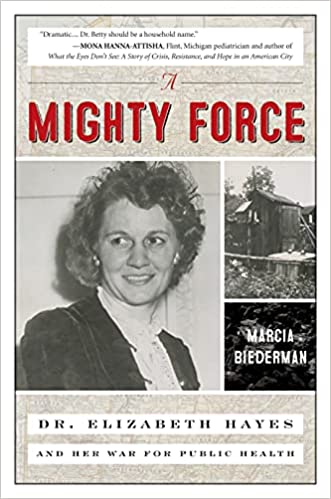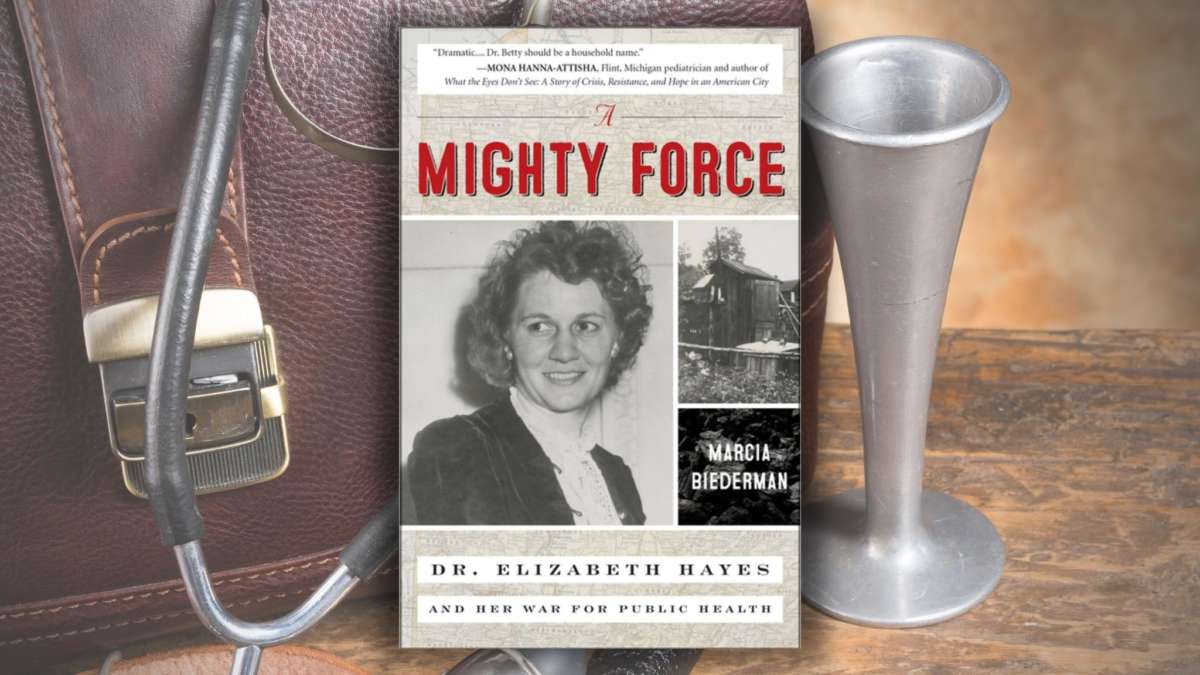A Mighty Force: Dr. Elizabeth Hayes and Her War for Public Health by Marcia Biederman
Dr. Elizabeth Hayes is not well-known, but she ought to be. According to Marcia Biederman, author of A Mighty Force: Dr. Elizabeth Hayes and Her War for Public Health (Prometheus), Dr. Hayes takes on a major corporate entity embroiled in corruption to make life better for her patients, the coal miners of Force, PA, a town owned by the Shawmut Mining Company. There was never a more apt title for this biography of a female powerhouse.
Biederman tells the compelling story of a woman who fought for better sanitation for the miners to prevent disease. It is difficult to conceive of Americans having to endure sewage in their yards, streets and rivers during the World War II era, seeping into their wells and contaminating their drinking water. Yet “Dr. Betty,” the Shawmut Mining Company’s physician, witnessed it firsthand through her visits to patients’ homes. Biederman describes each house as having “a sagging porch, a coal shed in the front yard, and an oozing outhouse in the back.” The unpaved roads cause Dr. Hayes to fall into a puddle of crud before arriving to deliver a baby. Those same muddy roads make it difficult for an ambulance to get through.
A suspected case of typhoid leads Hayes to pay for private testing of the wells. As she suspects, the water is contaminated. It is no wonder, since Shawmut neglects to maintain the outhouses. As a result, rainstorms cause feces to flow down streets and alleys. Such conditions force Hayes to resign her position, citing that “I see no point in maintaining Well Baby clinics if we are going to mix the babies’ formulas with toilet water.”
THIS JUST CAN’T GO ON
Her decision results in the 350 coal miners walking off the job, refusing to work without a doctor. Hayes pledges to remain and help the men fight for better conditions. Since the corporate overlords view their workers as “cartoonish, content with their lot, clothed but not quite human,” it would be an uphill battle. To further complicate matters, Shawmut Mining Company has been in receivership for forty years, using it as a scheme to enrich its executives. Such corruption would need to be exposed to achieve victory for the men.
Dr. Hayes becomes an instant celebrity and media darling with the press. An attractive woman dressed in “ruffled blouses, appliqued dresses, puckered sleeves, and veiled hats” fighting for public health made for a captivating story. The Philadelphia Record, a major daily newspaper, applauded Hayes’ mission and her motto: “Get good and mad — and start fighting.” Her battle for the miners achieves international recognition as papers across America and the world pick up on the story. While not inviting nor enjoying her fame, Hayes did use it to her advantage. Biederman writes, “The overnight sensation handled the media like a seasoned pro. Always quotable but often limiting herself to a few talking points, she kept her guard up with all but a few journalists.” Major publications such as the New York Times and Newsweek present her case in a sympathetic light; many writers, particularly gossip columnists, are particularly enthralled with “Dr. Betty.”
Marcia Biederman’s background as a newswoman and fiction writer serves her well in telling the story of Dr. Elizabeth Hayes. A Mighty Force exhibits a crisp, journalistic style that moves the story with a sense of urgency. I sometimes found it challenging to keep track of all the players. Still, the importance of Dr. Hayes’ contribution to the public health fight of deserving miners makes the extra work of reading attentively well worth the time.
A Mighty Force is an important story that brings to the forefront forgotten people: the downtrodden workers and the woman doctor who put aside her own needs and desires to fight for their cause. Dr. Hayes is a fine example of how to make the world a better place. A Mighty Force ensures that her story lives on.
Q&A WITH THE AUTHOR
Q: How did you come to know of Dr. Betty Hayes? Was it your interest in the time period, her medical background, the role of women during World War II, etc.?
A: Ironically, I was searching for a businesswoman to write about when instead I stumbled upon Dr. Hayes, who effectively became a labor leader despite having no official position in any union. My previous two biographies were about 20th-century female entrepreneurs, restaurateur Patricia Murphy and speed-reading marketer Evelyn Wood. Both those women had been featured in a magazine called the Investor’s Reader, published by Merrill Lynch from 1943 to 1973. Surprisingly, that pocket-sized digest ran financial news about women fairly regularly.
So I went to the New York Public Library to consult the magazine’s end-of-year indexes and skim them for women’s names. Any time I saw a name like Alice or Sally in the index, I’d request the issue and read the article. After a few false starts, I found Dr. Elizabeth Hayes and her struggle for sanitation under the heading, “The Doctor Prescribed.” Her actions ended a 40-year corporate scheme that enriched its executives while letting coal communities fester and creditors go unpaid. Investor’s Reader applauded her for it.
Q: How did your journalistic background help you to research this book? How did you know that so much had been written about her in the newspapers?
A: I immediately found scores of articles about her through the usual databases: newspapers.com, Proquest and so forth. Editorial writers nationwide were rooting for “Dr. Betty’s miners,” as one paper called them, and G.I.s overseas followed the strike in Stars and Stripes. Locating the stories was easy but I had to re-read them to find the arc of the story — how the central figures were changed by events.
Here my fiction writing background served me better than my experience in journalism. For example, at one point, I detected Hayes’s panic at becoming an overnight celebrity. Known for her kindness with patients, she turned testy with an interviewer who asked her a few innocent personal questions: whether she had a boyfriend and if she’d seen a particular movie. Soon after, Hayes fled town for a few days on an unannounced “vacation,” which was very unusual for her. I noticed another dip in Hayes’s morale when her mother moved from the house they’d shared. It must have been hell for Hayes to lead a struggle and work endless hours as a doctor with all her relatives living elsewhere.
Q: Did you realize when you started researching Betty Hayes that there were no personal papers that had survived? How did you manage without such important material? I imagine it must have been difficult not being able to read her own words on the matter.
A: I would have loved to have had her papers, of course, but this is an occupational hazard for all biographers of forgotten or unsung women. I had many quotations from her from reputable reporters with whom she’d forged relationships, and I spent many hours connecting dots and reading between lines. Thanks to the Indiana University of Pennsylvania collections, I also have an account of the demands she made to the mining company at a meeting where she thoroughly shocked the executives present. I’m also grateful to the Cornell University Library for the scrapbook and correspondence of a local grocer who followed every twist and turn of the strike and its aftermath. I also have an affidavit she signed after company officials raided her medical office. All of this gave me a clear picture of her and added to the story. Even if I had found her letters, they probably would have offered only one side of the correspondence.
Q: What was your reaction to the conditions that the miners had to live in? I was surprised that, in the 1940s, conditions were so poor. Was this part of the draw of writing this book?
A: I was, indeed, shocked to learn that the Pennsylvania Department of Health tolerated this level of filth in 1945. In the first decade of the century, there had been a terrible typhoid epidemic in Butler, PA, traced to fecal contamination of the water supply — the very same problem that existed in Force. After trying unsuccessfully to conceal the infections and deaths, Butler ended up begging the nation for help. Money and medical staff poured in, and Clara Barton took charge.
Yet less than 40 years later, state authorities said there was little they could do for Force because company-owned towns were private property. If Hayes hadn’t sounded alarms and persuaded a federal judge to order a clean-up, who knows what would have happened? By 1945, antibiotics were available, but prevention is better than treatment, as we’re re-learning now. I finished my research and began writing at the start of the pandemic and the new focus on public health, which gave me fresh reasons to tell Hayes’s story.





